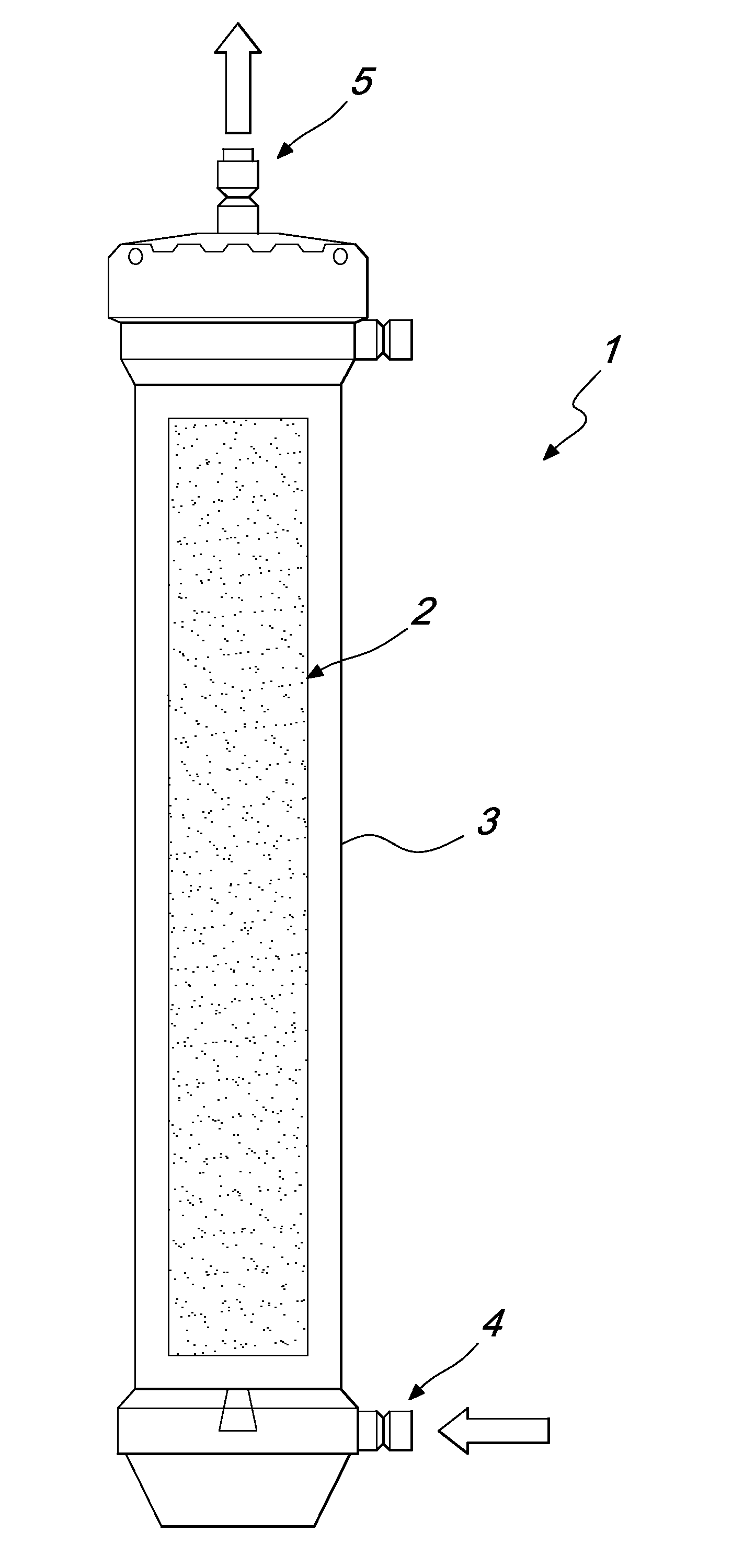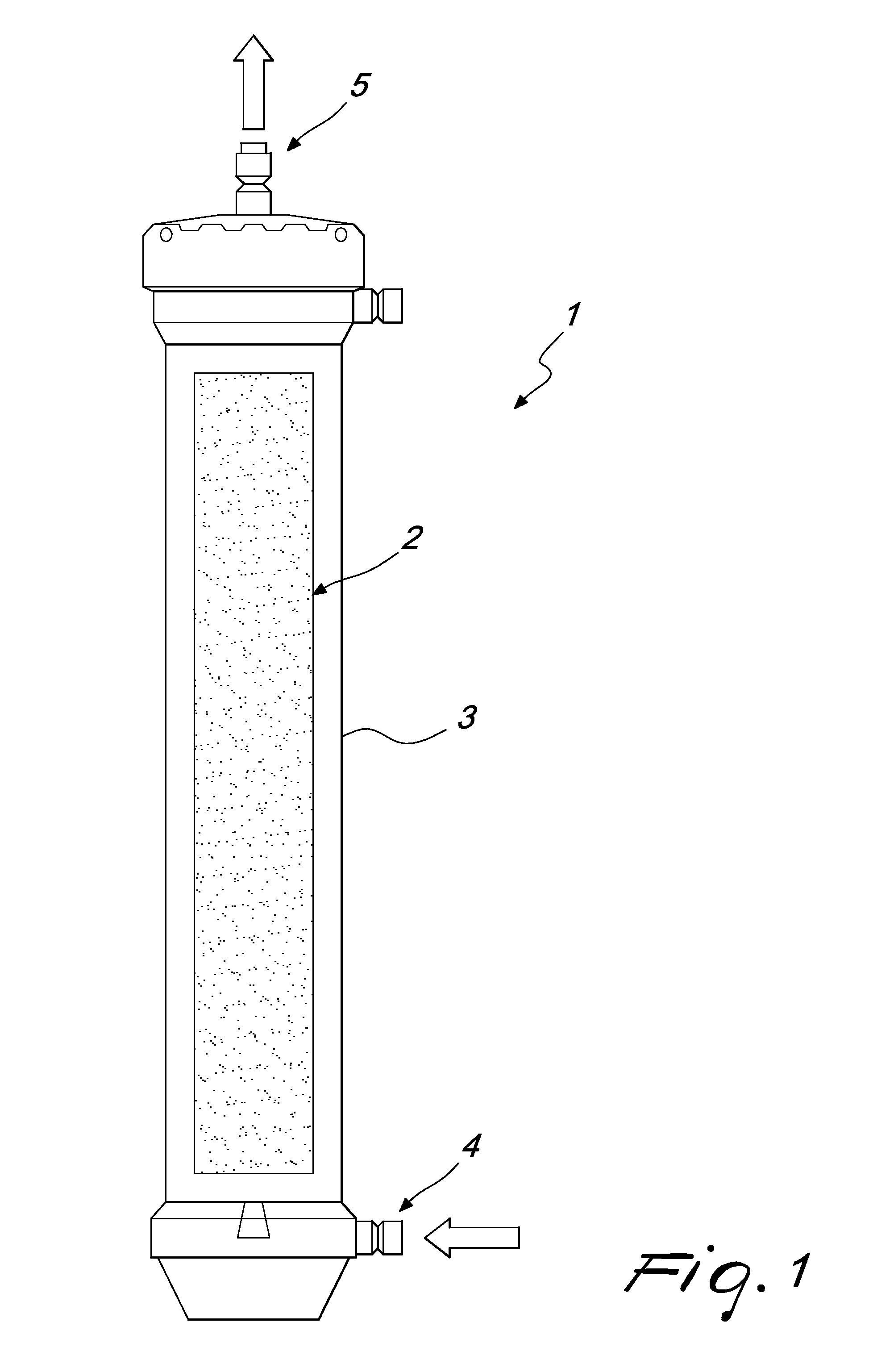Device for reducing the content of polluting and/or unwanted substances, particularly in water and other fluids
a technology for reducing the content of polluting and/or unwanted substances, which is applied in the direction of gravity filters, immobilised enzymes, enzymes, etc., can solve the problems of reducing effectiveness and reliability, permanent malfunction of the involved structures, and progressively affected surface lapped effects of the surface lapped
Inactive Publication Date: 2014-08-14
ARCHIMEDE R&D
View PDF2 Cites 8 Cited by
- Summary
- Abstract
- Description
- Claims
- Application Information
AI Technical Summary
Benefits of technology
[0018]The aim of the present invention is to solve the problems mentioned above, providing a
Problems solved by technology
Among unwanted substances (for example those that can be contained in drinking water), calcium carbonate (i.e., one of the inorganic salts of calcium) plays a fundamental role; its presence in the water often determines the deposition in solid form of residues (usually known as limescale), thus constituting a problem that currently is strongly felt in various sectors of application.
Therefore, as the hardness of the water and/or other fluid (determined by the concentration of calcium and magnesium ions, in the form of sulfate salts, chloride salts, nitrate salts, carbonate salts or hydrogen carbonate salts) increases, so does the danger that the surfaces lapped thereby are progressively affected by the formation of limescale deposits of increasingly large dimensions.
The deposits that therefore form on objects such as for example the walls of pipes, of resistance heaters, of exchangers, etcetera (of electrical household appliances, boilers, etcetera), determine very high load losses, with subsequent reduction in effectiveness and reliability and even considerable economic damages; moreover, the reduction of the passage area in the pipes, caused by limescale, can cause blockages and permanent malfunctions to the structures involved.
This system is rather effective, but has various problems, including corrosion phenomena that can cause failure of pipes, boilers and radiators; other problems are linked to the maintenance of said resins, which have to be treated periodically with bactericides and need regeneration with substances that, especially in the industrial field, cause an increase of the polluting load of sewage water.
Another chemical treatment is the one with polyphosphates, which entails the use of phosphates in order to form, together with the calcium carbonate, a single stable macromolecule; since polyphosphates are toxic (and so are some waste products obtained with this process), this method is used generally only for the treatment of water intended for industrial consumption and moreover has problems linked mainly to the difficulty in achieving correct dosage of the polyphosphates.
Another method is also known to prevent the forming of limescale: electrodialysis
Method used
the structure of the environmentally friendly knitted fabric provided by the present invention; figure 2 Flow chart of the yarn wrapping machine for environmentally friendly knitted fabrics and storage devices; image 3 Is the parameter map of the yarn covering machine
View moreImage
Smart Image Click on the blue labels to locate them in the text.
Smart ImageViewing Examples
Examples
Experimental program
Comparison scheme
Effect test
 Login to View More
Login to View More PUM
| Property | Measurement | Unit |
|---|---|---|
| Fraction | aaaaa | aaaaa |
| Fraction | aaaaa | aaaaa |
| Fraction | aaaaa | aaaaa |
Login to View More
Abstract
A device for reducing the content of polluting and/or unwanted substances in water, including a support made of polymeric material for a catalyst of the reaction of degradation of inorganic salts into gaseous substances; the catalyst, intended to reduce the energy required for the activation of the reaction and to accelerate its course, is an enzyme preferably selected from the group of lyases, and even more preferably selected from the subgroup of carbonic anhydrases. The inorganic are being carbonates, and/or hydrogen carbonates of calcium and/or magnesium, the reaction being the reaction of decarboxylation and acting for the conversion of inorganic salts into carbon dioxide and water according to the following reaction:
HCO3−+H+H2O+CO2.
Description
BACKGROUND[0001]1. Technical Field[0002]The present invention relates to a device for reducing the content of polluting and / or unwanted substances, particularly in water and other fluids.[0003]2. Description of Related Art[0004]Currently, as is known, the waters of natural or artificial watercourses, lakes, rivers, seas and underground water-bearing layers are used to varying extents in the industry. In order to allow this use, the water must be treated and / or purified, because it contains, besides its natural components, also variable quantities of impurities, constituted more frequently by suspended substances, such as sands, clays, organic debris, that make the water turbid and opalescent, in addition to dissolved substances such as organic substances and mineral salts (but also dissolved gases), particularly alkaline earth salts (calcium and magnesium) that are among the leading factors that determine water hardness (defined as the content of calcium and magnesium ions known in ...
Claims
the structure of the environmentally friendly knitted fabric provided by the present invention; figure 2 Flow chart of the yarn wrapping machine for environmentally friendly knitted fabrics and storage devices; image 3 Is the parameter map of the yarn covering machine
Login to View More Application Information
Patent Timeline
 Login to View More
Login to View More IPC IPC(8): C02F3/34C02F5/10C02F3/10
CPCC02F3/342C02F5/10C02F3/108Y02W10/10
Inventor PANIZZA, LUCIO
Owner ARCHIMEDE R&D
Features
- R&D
- Intellectual Property
- Life Sciences
- Materials
- Tech Scout
Why Patsnap Eureka
- Unparalleled Data Quality
- Higher Quality Content
- 60% Fewer Hallucinations
Social media
Patsnap Eureka Blog
Learn More Browse by: Latest US Patents, China's latest patents, Technical Efficacy Thesaurus, Application Domain, Technology Topic, Popular Technical Reports.
© 2025 PatSnap. All rights reserved.Legal|Privacy policy|Modern Slavery Act Transparency Statement|Sitemap|About US| Contact US: help@patsnap.com



